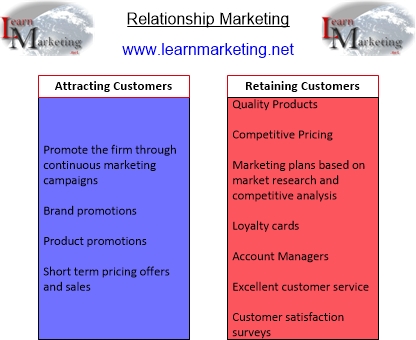Welcome to LearnMarketing.net
Relationship Marketing
Introduction
Relationship marketing involves developing long term relationship with customers so that they provide you with ongoing business. An organisation must exceed customer satisfaction expectations to retain and develop long term relationships with customers. Traditional transactional marketing focused on attracting customers for "one off sales" rather than repeat business. However it takes a lot of work to persuade customers to make their first purchase with you, so if you can persuade customers to give you repeat business it will cost you less time and money.
This relationship marketing diagram gets us started by showing how the actions involved in attracting customers, are different to the ones involved in retaining customers for the long term.
Attracting and Retaining Customers
Relationship marketing involves the organisation implementing strategy to attract and retain customers over the long term. Methods used to attract customers include lots of marketing campaigns promoting the firm, its products, its brands and its special (pricing) offers. Methods used to retain customers include good quality products, competitive prices, loyalty cards, a focus on customer satisfaction, excellent customer service and even individual account managers for larger or premium clients.
Customer Satisfaction Monitoring
To retain customers over the long term you need customer satisfaction even when things do not go to plan. So firms will continuously monitor how their customers are feeling about the service they have provided. For example Travelodge email customers a feedback form to complete as soon as they have completed their stay at a Travelodge hotel. Methods used to monitor customer satisfaction include
After each monitoring session a firm will review the results and plan how they can rectify areas causing dissatisfaction. They will also look at how the firm can build on factors that made their customers happy.
Conclusion
It is important to monitor customer satisfaction regularly as customer "wants and needs" continuously change. Adapting and changing to reflect customer requirements will help the organisation develop the long term relationship it wants with customers.




